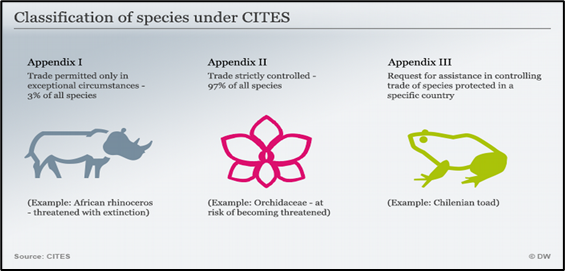Why in News?
- The CITES trade database includes 28 instances of Red Sanders confiscation, seizure and specimen from the wild being shipped from India.
- This was highlighted by a fact sheet created by TRAFFIC, a global wildlife trade monitoring organisation.
What’s in Today’s Article?
- What is CITES?
- What is TRAFFIC?
- What is Red Sanders?
- News Summary Related to CITES Database on Red Sanders Smuggling
What is the Convention on International Trade in Endangered Species of Wild Fauna and Flora (CITES)?
- Also known as the Washington Convention, it is an international agreement (Secretariat - Geneva, Switzerland) between governments to ensure that international trade in wild animals and plants does not threaten the survival of the species.
- It was drafted at a meeting of members of the International Union for Conservation of Nature (IUCN) in 1963.
- The convention was opened for signature (in Washington D.C.) in 1973 and CITES entered into force on 1 July 1975.
- With 184 Parties today (India since 1976), CITES is one of the conservation treaties with the most members.
- Although CITES is legally binding on the Parties (meaning they must implement the Convention), it does not replace national legislation.
- Rather, it establishes a framework (on which domestic law of each Party must be enacted) that must be followed by each Party.
- Under CITES, plant and animal specimens are classified into three categories (Appendices) based on the threat to their extinction.

What is TRAFFIC (Trade Records Analysis of Flora and Fauna in Commerce)?
- Also known as the Wildlife Trade Monitoring Network, TRAFFIC is a global non-governmental organisation monitoring the trade in wild animals and plants with focus on biodiversity and sustainable development.
- It was originally created in 1976 as a specialist group of the Species Survival Commission of the IUCN and evolved into a strategic alliance of the World-Wide Fund for Nature (WWF) and the IUCN.
- It also provides trade information and expert analysis to the decision-making process at CITES (such as through the Elephant Trade Information System) to ensure that international trade in wildlife remains at sustainable levels.
- Some of the important projects of TRAFFIC:
- Reducing trade threats to Africa’s wild species and ecosystems through strengthened knowledge and action in Africa and beyond (ReTTA).
- Wildlife Trafficking Response, Assessment and Priority Setting (Wildlife-TRAPS).
- The Global Shark and Ray Initiative.
- The FairWild Foundation.
What is Red Sanders (Red Sandalwood)?
- The species, Pterocarpus santalinus, is an Indian endemic tree species (growing up to a height of 10 to 15 metres), with a restricted geographical range in the Eastern Ghats.
- The species is endemic to a distinct tract of forests in Andhra Pradesh and is a very slow-growing tree species that attains maturity in natural forests after 25-40 years.
- It is highly sought after throughout Asia, especially in China and Japan, for use in cosmetics and pharmaceutical items as well as for building furniture, woodcraft and musical instruments.
- They are also known for their healing capabilities and rich colour.
- Threats: The species has experienced a population decline of 50-80% in the last 50 years due to smuggling, forest fires, cattle grazing and other anthropogenic threats and spread of diseases like spike disease.
- It was a moment of celebration when the species was lifted off from the endangered category for the first time since 1997 (classified as ‘near threatened’ in 2018).
- However, it has fallen back into the ‘endangered’ category in the IUCN Red List in 2021. It is also protected under CITES (Appendix II) and the Wildlife Protection Act 1972 (Schedule IV).
- In 2016, the Andhra Pradesh Forest Act was amended to give special status of protection and Red Sanders offences were made cognisable and non-bailable.
News Summary Related to CITES Database on Red Sanders Smuggling:
- “RED SANDERS: Factsheet on India’s Red Sanders in illegal wildlife trade:”
- The species is reported to be one of India’s most exploited tree species and is under severe pressure from illegal logging and harvesting.
- Its heartwood is in demand in both domestic and international markets and is used to make furniture and handicrafts, while the red dye obtained from the wood is used as a colouring agent in textiles and medicines.
- Under the foreign trade policy of India, the import of Red Sanders is prohibited, while export is restricted.
- India reported an export of more than 19,049 tonnes of logs. However, the importing countries reported about 4,610 tonnes of logs, clearly indicating a discrepancy in reporting of Red Sander trade.
- China remains the largest importer with more than 13,618 tonnes of the products, followed by Hong Kong (5,215 tonnes) and Singapore (216 tonnes).
- Conservation efforts needed:
- The publication called for declaring the Red Sanders harbouring forests within the species’ geographical range as ‘High Conservation Areas’, to provide an adequate legal framework for protecting the species and its habitat.
- Enforcement agencies such as the Forest Departments, Customs, Railways, Police, DRI (Directorate of Revenue Intelligence) and Coast Guards must coordinate efforts to curb the Red Sanders trafficking.
- This can be done by sharing information on hotspots and transit routes and real-time intelligence related to the Red Sanders smuggling.










